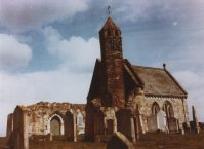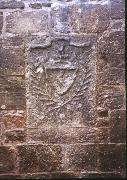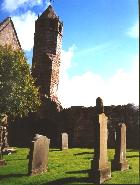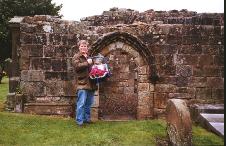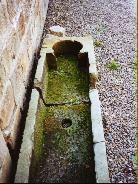|
|
|
|
|
|
INGLIS' AISLE
St Bride's Church, Douglas, Scotland
The roofless south transept, which is invariably known as the Inglis' Aisle, is worth close examination. The traditional story behind the name is as follows: In the early years of the fourteenth century, when Douglasdale was repeatedly overrun and often held by the English, the Inglis- family tenanted the farm of Weston. Once Inglis managed to overhear the English plans for taking the castle, and at very great risk conveyed a warning to the Douglas. For this and perhaps other services he was asked to name his reward, and he replied that his greatest wish was to be buried under the same roof as his master. Accordingly, the south transept was set apart as the burial place of Inglis and his descendants for all time. So goes the tale, and until comparatively recent years descendants of the Douglas Inglises have been buried there. There are several memorial tablets on the walls, some bearing the Inglis coat of arms and the family motto, " Recte faciendo securus ". A fragment of a local rhyme survives in the couplet:
It was gi'en to Inglis and Ingliss bairns
And a' that lie in Inglis's airms.
The walls of the aisle appear to be only twelve feet high at the part where they are best preserved, but actually the ground both inside and outside the building is quite five feet above its original level. The old level can be seen at the foot of the ladder leading to the tower door. This rise of the ground is by no means uncommon in a churchyard, especially in one of limited area within strong containing walls. It is often due simply to centuries of interments, but where, as in St. Bride's, a great building has disappeared, the small rubble not worth removing for other buildings or road-making will also contribute a good deal to the burying of foundations and of surviving fragments of walls.
The Inglis' Aisle is entered from the churchyard by a door in a weather-worn archway which appears to be the original doorway, though its true proportions are concealed by the high soil level.
References are often made to the use of a corner of the old church, during the eighteenth century, as the prison or tolbooth of the district, and it would appear that it was in the Inglis' Aisle that malefactors were confined. To the side of the door were attached the "jougs", instruments of punishment which kept the culprit standing upright against the wall, with an iron bar under the chin.
The aisle was separated from the nave by two fine arches each spanning about sixteen feet. At some time unknown, they were blocked up to form a solid wall, but their position is still clearly visible. The best preserved part is within the tower, and here at the spring of the arch a stone bracket for a statue survives. On the outside of the aisle, the arches can be traced as they would have appeared from the nave. The central pillar is particularly fine:
it is octagonal with 10-inch sides, and has a niche for a statue.
-Inside the aisle lies a much damaged stone coffin, enclosing a small lead case which was made about fifty years ago to contain the bones exposed when the lid was broken. Part of the original covering stone remains, and bears the inscription:
THE SEPULCHRE OF THE INGLISES IN BRAIDLIE 1432.
|
|
|
|
|


